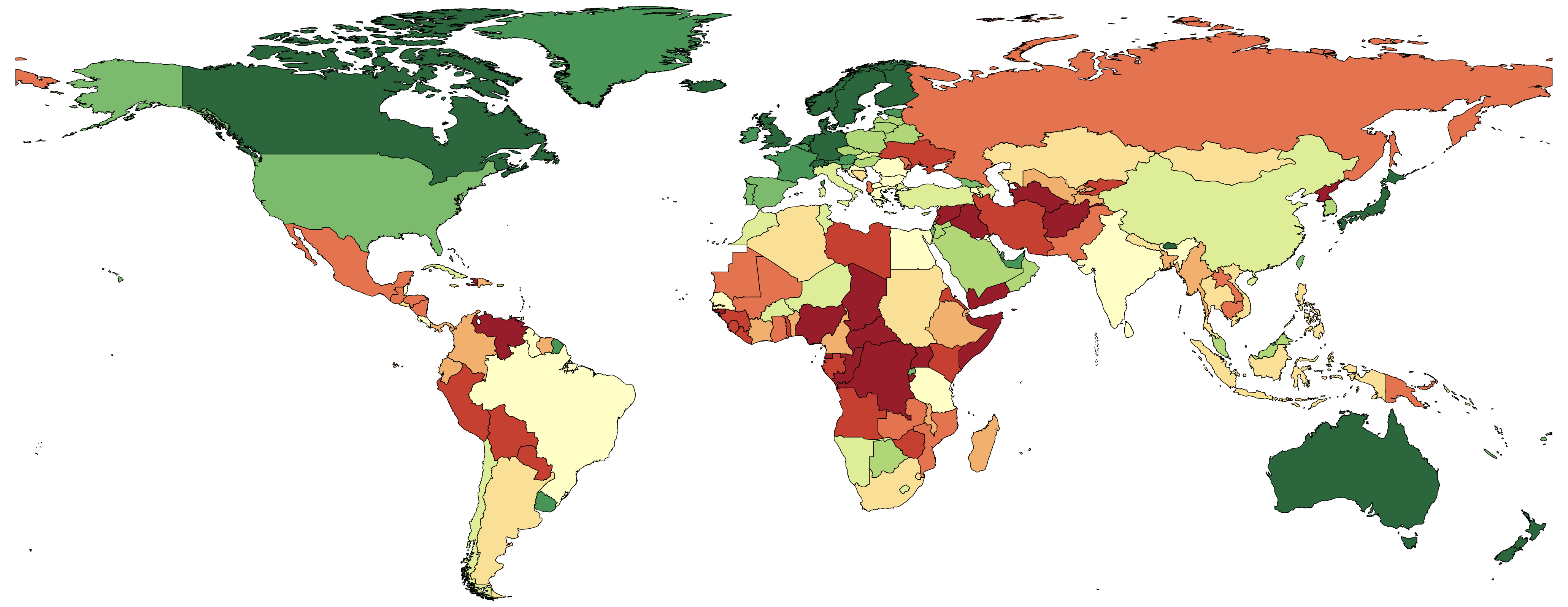The
Bayesian Corruption Index
2023 update
Worldwide corruption perception estimates from 1984 to 2021

Map
of the BCI values in 2021.
Notes: Countries and regions marked by high corruption are indicated in red, those with little or no corruption are colored dark green.
Source: Standaert, 2015.
Notes: Countries and regions marked by high corruption are indicated in red, those with little or no corruption are colored dark green.
Source: Standaert, 2015.
About
The
Bayesian Corruption Index is a composite index of the perceived
overall level of corruption:
The augmentation allows an increase of the coverage of the BCI: a 60% to 100% increase relative to the WGI and CPI, respectively. In addition, in contrast to the WGI or CPI, the underlying source data are entered without any ex-ante imputations, averaging or other manipulations. This results in an index that truly represents the underlying data, unbiased by any modeling choices of the composer.
The construction of the index and its advantages are described in greater detail in the paper listed below.
How do I
use and interpret the BCI values?
The BCI index values lie between 0 and 100, with an increase in the
index corresponding to a rise in the level of corruption. This is a
first difference with CPI and WGI where an increase means that the
level of corruption has decreased. - Corruption: With corruption, we refer to the “abuse of public power for private gain”
- Perceived corruption: Given the hidden nature of corruption, direct measures are hard to come by, or inherently flawed (e.g. the number of corruption convictions). Instead, we amalgamate the opinion on the level of corruption from inhabitants of the country, companies operating there, NGOs, and officials working both in governmental and supra-governmental organizations.
- Composite: It combines the information of 17 different surveys and 110 different survey questions that cover the perceived level of corruption.
The augmentation allows an increase of the coverage of the BCI: a 60% to 100% increase relative to the WGI and CPI, respectively. In addition, in contrast to the WGI or CPI, the underlying source data are entered without any ex-ante imputations, averaging or other manipulations. This results in an index that truly represents the underlying data, unbiased by any modeling choices of the composer.
The construction of the index and its advantages are described in greater detail in the paper listed below.
How do I
use and interpret the BCI values?
There exists no objective scale on which to measure the perception of corruption and the exact scaling you use is to a large extent arbitrary. However, we were able to give the index an absolute scale: zero corresponds to a situation where all surveys say that there is absolutely no corruption. On the other hand, when the index is one, all surveys say that corruption is as bad as it gets according to their scale. This is another difference with CPI and WGI, where the scaling is relative. They are rescaled such that WGI has mean 0 and a standard deviation of 1 in each year, while CPI always lies between 0 and 100.
In contrast, the actual range of values of the BCI will change in each year, depending how close countries come to the situation where everyone agrees there is no corruption at all (0), or that corruption is as bad as it can get (100).
The absolute scale of the BCI index was obtained by rescaling all the individual survey data such that zero corresponds to the lowest possible level of corruption and 1 to the highest one. We subsequently rescaled the BCI index such that when all underlying indicators are zero (one), the expected value of the BCI index is zero (one).
Significance of changes over time and differences between countries
Unlike the WGI and CPI indicators, the values of the BCI index can be used to compute the significance of changes in the level of corruption over time or differences between countries.
The reason is that estimating the BCI index results not just in a point estimate (BCIi,t) of the level of corruption for each country i and year t. Instead it returns thousand of draws from the entire distribution of this estimate. The significance can easily be computed using these draws. If less than 5% of all draws, the level of corruption of country A is lower than that of B, we can state that B’s level of corruption is significantly lower at the 5% significance level.
Every year, the Corruption Perception Index will publish a ranking of countries based on their level of corruption. However, these rankings have been criticized for being very sensitive to the smallest of differences in the actual scores of countries. To address this problem, the ranking of the countries in the BCI dataset only uses these significant differences. A country will have a higher rank if, and only if, it is significantly more corrupt than at least one country with a lower ranking. This allows for a more meaningful comparison of the level of corruption between countries than a simple ranking would allow. Only if a decrease in corruption is large enough, will a country actually achieve a higher ranking.
A dataset containing a thousand random draws of the BCI values is posted on the website, allowing users to perform their own analyses. The article “Divining the level of corruption” (Standaert, 2014) discusses various ways in which these draws can be used to make robust inferences. Desbordes and Koop (2015) discuss an alternative (frequentist) way in “The known unknowns of governance.”
Cite
Please cite as: Samuel Standaert (2015) "Divining the Level of
Corruption: a Bayesian State Space Approach", Journal of
Comparative Economics, 43 (3) 782-803. DOI: 10.1016/j.jce.2014.05.007
Download
Click here to download the worldwide BCI indicator in csv
format or in Stata 15's dta format
from 1984 to 2017. It contains the following variables:
- iso: the 3 digit ISO codes
- name: the country names
- year
- BCI: the Bayesian Corruption Indicator
- BCI_std: the standard deviation of each estimate
- sources: number of individual indicators available in that year
The
list of data sources and survey questions used for the 2023 update
can be found here.
Contact
For questions or comments, contact me at Samuel.Standaert@UGent.be
Funding provided by the European Union's Horizon 2020 research and innovation program under the Marie Sklodowska Curie grant agreement No 665501 with the Research Foundation Flanders (FWO) and the Belgian National Bank.
 |
|
 |